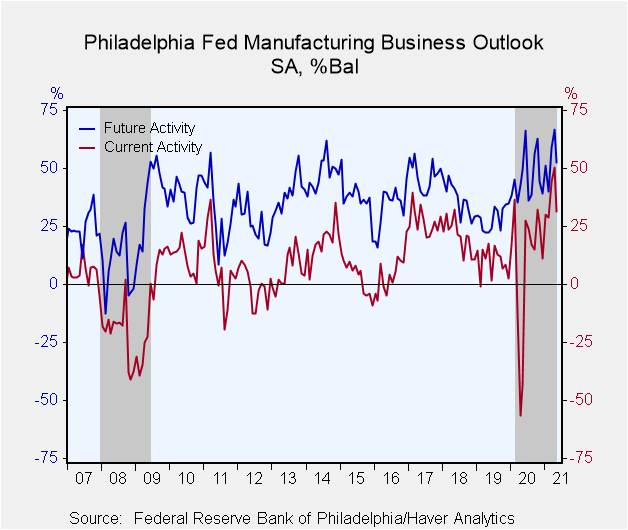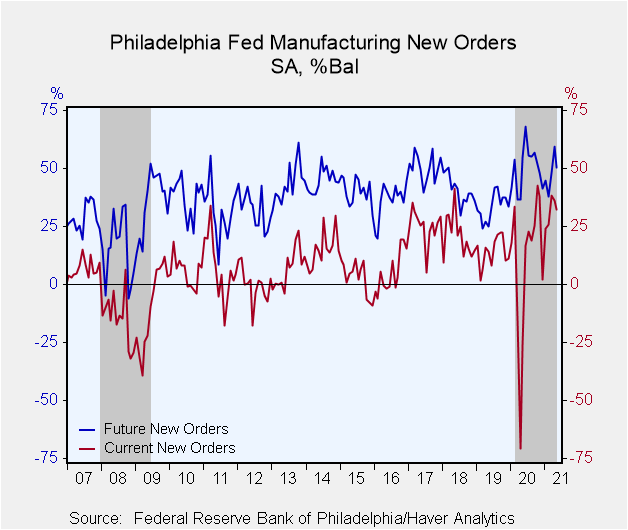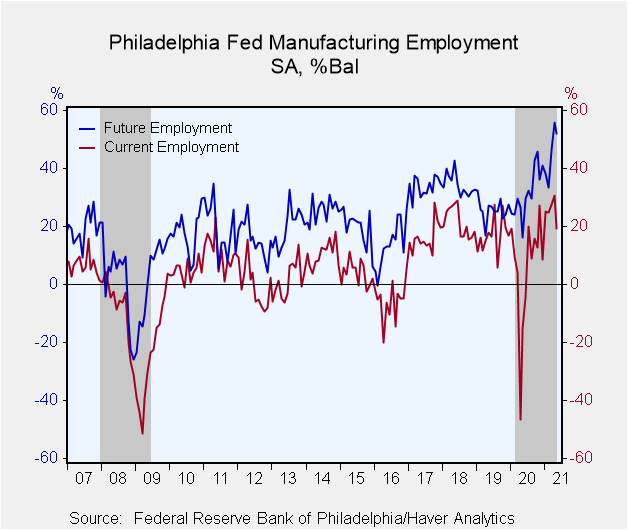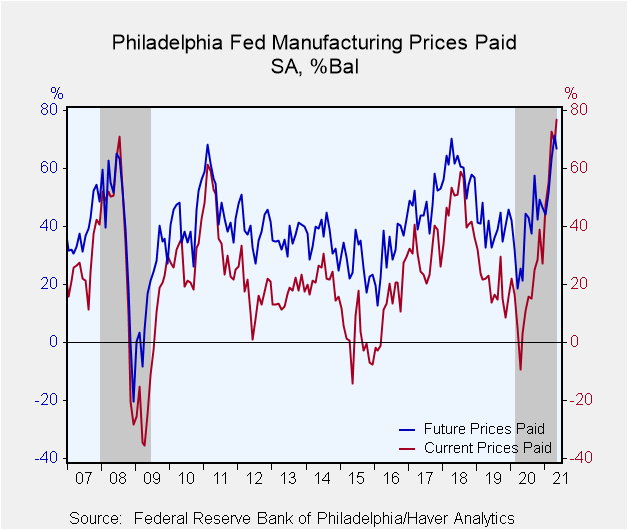 Global| May 20 2021
Global| May 20 2021Philadelphia Fed Manufacturing Index Weakens in May
by:Tom Moeller
|in:Economy in Brief
Summary
• Headline index reverses two months of increase. • Components are mixed m/m but continue to indicate expansion. • Prices paid continue to strengthen. The Federal Reserve Bank of Philadelphia's Factory Sector Business Conditions Index [...]
• Headline index reverses two months of increase.
• Components are mixed m/m but continue to indicate expansion.
• Prices paid continue to strengthen.
The Federal Reserve Bank of Philadelphia's Factory Sector Business Conditions Index fell sharply to 31.5 during May following a jump to 50.2 in April. A decline to 41.5 had been expected in the Action Economics Forecast Survey. The percentage of firms reporting improving conditions declined to 43.4% after surging to 58.6% in April, while the share reporting weaker conditions rose to 11.9%, the most since December.
Haver Analytics calculates an ISM-Adjusted General Business Conditions Index using the same methodology as the national ISM index. The reading eased to 62.7 from 63.0 in April, which was the highest level since March 1973.
Amongst the subindexes, the employment reading fell to 19.3 from the record 30.8 in April. A lessened 25.6% of survey respondents reported increased employment while a higher 6.3% reported less hiring. The unfilled orders measure surged to a near-record 41.5. New orders and shipments eased, but the average workweek rose 35.5. It reversed most of its April decline.
On the pricing front, the index of prices paid rose to 76.8 in May, the highest level since March 1980. An increased 76.8% of respondents paid higher prices while none paid less. The index of prices received strengthened to 41.0, also a 40-year high.
The Philadelphia Fed also surveys expectations for business activity in six months. The Future Activity Index declined to 52.7 in May from 66.6 in April. Expected employment, new orders and shipments fell m/m but remained in an upward trend. The future prices paid measure eased.
The survey panel consists of 150 manufacturing companies in the third Federal Reserve District (which consists of southeastern Pennsylvania, southern New Jersey and Delaware). The diffusion indexes represent the percentage of respondents indicating an increase minus the percentage indicating a decrease in activity. The ISM-adjusted figure, calculated by Haver Analytics, is the average of five diffusion indexes: new orders, shipments, employment, delivery times and inventories with equal weights (20% each). Each ISM-adjusted index is the sum of the percent responding "higher" and one-half of the percent responding "no change."
The figures from the Philadelphia Federal Reserve dating back to 1968 can be found in Haver's SURVEYS database. The expectation from the Action Economics Forecast Survey is available in AS1REPNA.
| Philadelphia Fed - Manufacturing Business Outlook Survey (%, SA) | May | Apr | Mar | May'20 | 2020 | 2019 | 2018 |
|---|---|---|---|---|---|---|---|
| General Factory Sector Business Conditions | 31.5 | 50.2 | 44.5 | -43.1 | 7.9 | 9.9 | 20.9 |
| ISM-Adjusted Business Conditions | 62.7 | 63.0 | 61.4 | 42.7 | 52.3 | 55.5 | 57.7 |
| New Orders | 32.5 | 36.0 | 38.2 | -25.7 | 8.9 | 14.1 | 21.0 |
| Shipments | 21.0 | 25.3 | 22.0 | -30.3 | 9.7 | 16.9 | 22.8 |
| Unfilled Orders | 40.4 | 27.2 | 19.3 | -13.7 | 0.4 | 7.7 | 7.0 |
| Delivery Time | 41.5 | 27.8 | 28.2 | -6.7 | 5.1 | 9.4 | 9.5 |
| Inventories | 25.6 | 17.3 | 14.4 | 11.7 | -0.2 | 5.1 | 7.2 |
| Number of Employees | 19.3 | 30.8 | 27.4 | -15.3 | 5.0 | 16.9 | 21.5 |
| Average Workweek | 35.5 | 29.8 | 36.4 | -7.1 | 4.4 | 9.8 | 15.9 |
| Prices Paid | 76.8 | 69.1 | 72.6 | 3.2 | 16.6 | 19.7 | 46.1 |
| Expectations - General Business Conditions; Six Months Ahead | 52.7 | 66.6 | 59.1 | 49.7 | 46.3 | 28.4 | 36.8 |
Tom Moeller
AuthorMore in Author Profile »Prior to joining Haver Analytics in 2000, Mr. Moeller worked as the Economist at Chancellor Capital Management from 1985 to 1999. There, he developed comprehensive economic forecasts and interpreted economic data for equity and fixed income portfolio managers. Also at Chancellor, Mr. Moeller worked as an equity analyst and was responsible for researching and rating companies in the economically sensitive automobile and housing industries for investment in Chancellor’s equity portfolio. Prior to joining Chancellor, Mr. Moeller was an Economist at Citibank from 1979 to 1984. He also analyzed pricing behavior in the metals industry for the Council on Wage and Price Stability in Washington, D.C. In 1999, Mr. Moeller received the award for most accurate forecast from the Forecasters' Club of New York. From 1990 to 1992 he was President of the New York Association for Business Economists. Mr. Moeller earned an M.B.A. in Finance from Fordham University, where he graduated in 1987. He holds a Bachelor of Arts in Economics from George Washington University.










